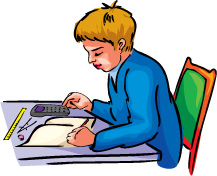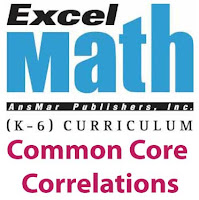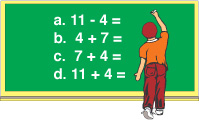 One of the most common pieces of advice we hear from excellent teachers around the country is that they begin on the very first day of school teaching students appropriate behavior in the classroom. (And then they repeat the process throughout the year.) These teachers suggest that some hard work, structure and organization up front save countless hours of discipline and heartache throughout the rest of the school year.
One of the most common pieces of advice we hear from excellent teachers around the country is that they begin on the very first day of school teaching students appropriate behavior in the classroom. (And then they repeat the process throughout the year.) These teachers suggest that some hard work, structure and organization up front save countless hours of discipline and heartache throughout the rest of the school year. Excel Math was written to give teachers the tools they need to develop a strong foundation of math in their students. For over 30 years, these math lessons have been proven to develop higher-order thinking skills, build proficiency, and produce confidence in students of all ages and abilities. Read more about Excel Math and its systematic spiraling process at excelmath.com.
Harry Wong (educational speaker who has taught middle school and high school science) from Mountain View, California, suggests teachers start school with a First Day of School script. He recalls, "One teacher began his year with fun activities and spent the rest of the school year chasing after his classes. His first day lacked structure, which led to his students structuring his classes for him. Elementary school teacher, Melissa Pantoja, began the first day of school with a script, which led to a successful beginning. " Read more at http://teachers.net/wong/NOV11/
Dr. Fred Jones, educational author and speaker suggests using a "Say, See, Do" educational model. "In the Say, See, Do Teaching method, you tell students what to do, you show them what to do, and then you have them do it. The process is repeated as students learn by doing…one step at a time." Read more from Fred Jones here.
Kirk Rogers, History teacher in El Cajon, California, begins the year by having his classes practice how to be engaged students. He spends some time during the first few days of the school year to teach his students how to enter and exit the room, retrieve clickers and put them away, use laptops appropriately, and many more routine procedures. He has students practice doing each procedure every day. If a student "forgets" the correct way to behave, he has that student repeat the procedure correctly. For example, a student who lifts up the laptop with one hand to put it away is asked to return to his desk with the computer, holding it with two hands. He must then open the cover, close it, pick it up (this time with both hands) and then may put it away. Fred Jones explains, "When a good teacher or coach sees a student make an error, he or she instinctively steps in at that moment to re-teach. Otherwise, the error would be repeated until it became a bad habit."
Explaining proper procedures and then having students repeat those procedures correctly during the first few days of school means less time wasted throughout the school year. Mr. Rogers uses the acronym SLANT to help his students remember to be active listeners:
SLANT =
Here's a Powerpoint SLANT reminder you can download and use with your own class. After presenting the slides and explaining the acronym, have your students practice it. If you have computers in your room, let your students use these slides as electronic flashcards. Divide the students into pairs, with each pair on a computer. Have them scroll through the slides. Let one student in each pair read the question when it appears. Have the other student try to answer the question before showing the next slide. Show the slide. If the student got it wrong, they go back to the first slide and each student reads that line five times before they move on to the next slide. Let the students take turns asking and answering the questions until they have the slides memorized. (This electronic flashcard technique works well for learning math terms and concepts, too.)

If a student forgets to take notes or pay attention, a simple reminder to "slant" can often take care of getting her refocused on the lesson at hand. According to Dr. Fred Jones, "To create student engagement, the teacher must succeed in managing both discipline and instruction. If kids are goofing off, you won't get much engagement."
Having a classroom routine often helps students feel secure and safe in the classroom. A predictable routine can also give students a sense of familiarity and confidence in knowing what is expected of them. Many teachers begin the class with a warm-up or bell work so students enter the classroom and are already working when the bell rings. For math warm-up activities and math worksheets you can download for your students, see our previous blog post, "Five Minute Math Class Warm-Up Activities."
Being prepared is a great way to keep your students' attention and to minimize lag time. Moving quickly from one activity to the next means students are engaged throughout the class. There is no reason to give students even a few seconds to become distracted or lose focus because the teacher has to collect materials or decide what to do next.
Clearly stating expectations before moving to the next activity helps clarify for students what the teacher is asking them to do. For example, knowing they need to get out a pencil and paper and not talk to their neighbor is a reasonable expectation. But when the teacher switches to a new activity, students sometimes feel they now have a chance to talk, move around, or ... (you fill in the blank). Watch an experienced teacher, Ms. Podolsky, use a variation of the "Say, See, Do" model to show her students how to move their desks into groups as quickly and quietly as possible. This is a helpful video showing how to introduce and then model procedures to students beginning at the start of the school year: http://youtu.be/Xhhxk26NfWM
Clarifying how you expect them to act during the next activity will stop many disruptions and misbehaviors before they begin. Letting students know what is expected during the transition time from one activity to the next helps keep the lesson moving. Watch veteran teacher Caltha Crowe put this into practice as she instructs her students how to line up on the first day of school: http://youtu.be/qArU7TjSBV0
Providing a classroom routine and structure beginning on the first day of school can help set the tone for effective classroom management from day one. We would love to hear what's working in your classroom. Feel free to leave a comment with your tips for other teachers.



























